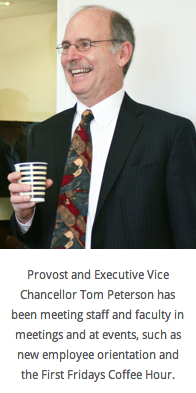New Provost Shares Vision for Campus
 Provost and Executive Vice Chancellor Tom Peterson assumed his leadership role at UC Merced on Dec. 3 and has been meeting with various campus groups to learn more about the university.
Provost and Executive Vice Chancellor Tom Peterson assumed his leadership role at UC Merced on Dec. 3 and has been meeting with various campus groups to learn more about the university.
Before coming to campus, Peterson led the Directorate for Engineering at the National Science Foundation (NSF), a $7 billion federal agency that invests in the nation’s research and education activities across science and engineering.
Peterson had also been on the faculty of the University of Arizona since 1977 and had served for 11 years as dean of the College of Engineering.
In this Q-and-A with Panorama, Peterson charts his vision for the campus and talks about how his experience with NSF and the University of Arizona has made him a better leader.
What are your top priorities your first six months on the job?
My No. 1 priority is to earn the trust and confidence of the faculty because I want to support their efforts to raise the stature of the institution. I want to help them shape the strategic directions for the university, knowing full well that there are many views about what those directions should be, and not all views can be accommodated. I believe in open and transparent leadership and operation, and the chancellor’s strong track record in these leadership qualities was an important factor in my decision to come here.
What attracted you to UC Merced?
It is rare to have the opportunity to be part of a "start-up" university. While UC Merced is well beyond the initial phase of development, it is, at least theoretically, relatively free to explore research and educational methodologies and pedagogies outside the bounds of traditional systems, and can, because of its size, implement those ideas on a reasonable timescale.
I came to UC Merced because, like so many of you, I was attracted to that possibility. I came because you are part of perhaps the best system of public higher education in the world. Our faculty members, in spite of the youth of the institution, are world-class researchers who have active research awards from every directorate at the National Science Foundation, as well as from many other sources.
Also, our student demographics represent the future of this country, both literally and figuratively, and UC Merced can be a model for all other public institutions for meeting the educational needs of those young people.
And finally, I was attracted by the vision of the leadership team here and wanted to be part of that team.
What qualities make someone a successful provost and executive vice chancellor?
A successful provost will view the job as one of service to the institution. The responsibility of the provost is to help ensure that students can get the best education possible, that faculty can be supported in their professional aspirations for research, teaching and service, and that the staff have the support to carry out effectively the day-to-day business of the university.
A provost has to be a good listener, open to the input and opinions of all campus constituents. I have to extract the best ideas from wherever they come: faculty, staff and students, as well as from outside constituents.
And, most importantly, a provost needs to know when all the voices have been heard on a particular issue, and when it is time to make a decision and move on.
Of course, this all has to be carried out in an environment of constrained resources which, in the end, presents the biggest challenge to the provost — how best to invest limited time, dollars and space to best advance the institution.
Do you see some of your experiences from National Science Foundation adding value to UC Merced?
My experiences both at the University of Arizona and the National Science Foundation will be beneficial in some ways to UC Merced, I hope. One of the most important things I learned at UA was the benefit of working collaboratively across departmental, college and even institutional boundaries. And at NSF, the programs addressing the grand-challenge problems effectively engaged researchers from a broad range of disciplines. UC Merced faculty are already experts at attracting NSF investment in their programs. I just hope my experiences with the agency will add some additional insight into programs, both at NSF and with many of NSF’s sister agencies, ideally suited to support our strategic research initiatives.
What is your vision for the campus and how do you make this vision a reality?
My vision for Merced is that we become a research-intensive university with the strength of commitment and recognition due all the campuses in this prestigious UC system. To do that, I believe, will require the discipline to focus on key areas and not try to become “all things to all people”. The challenge is essentially one of finding the appropriate balance between nurturing and expanding into these key areas, and at the same time providing the foundational curricular elements expected in a university our size.
Since our size is changing, so too will be the relative weight we put on investments following these two approaches. At this point in time, I strongly believe the chancellor’s approach to building our strategic focusing activities around the research programs is the correct one. We must always keep in mind of course, regardless of how we organize our strategic thinking, that all our faculty members must advance both the graduate and undergraduate educational needs of the institution.
